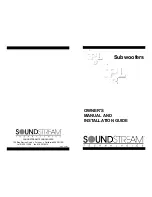
8
SUGGESTED ENCLOSURES
Infinite Baffle
Sealed
•
.5 ft
3
- Good linear
response, excellent
small enclosure.
Excellent for high
SPL, multiple driver
applications.
•
1.5 ft
3
- Good linear
response, excellent
all around enclosure.
Vented
•
.75 ft
3
@ 50 Hz (4" x
11.5" port) - High
output. Good small
enclosure.
•
1.0 ft
3
@ 40 Hz (4" x
14.25" port) - High
output with good low
frequency extension.
Great for Rock
music.
Vented (V)
Sealed (S)
50
55
60
65
70
75
80
85
90
95
100
10
100
1000
Frequency Hz
dB
50
55
60
65
70
75
80
85
90
95
100
10
100
1000
Frequency Hz
dB
50
55
60
65
70
75
80
85
90
95
100
105
10
100
1000
Frequency Hz
dB
50
55
60
65
70
75
80
85
90
95
100
105
10
100
1000
Frequency Hz
dB
5
Sealed Bandpass Enclosure
Sealed bandpass enclosures enclose both sides of the
woofer(s). An airtight enclosure is built around the front and back of
the woofer and one chamber is ported to a specific frequency.
CALCULATING (NET) INTERNAL ENCLOSURE VOLUMES
When constructing any type of enclosure, you must be aware that the
outside dimensions DO NOT represent the true (Net) volume inside.
Such things as woofers, ports, thickness of enclosure material, dividing
walls, and any internal bracing will reduce the total amount of the
actual air space available. The following worksheet has been designed
to provide you with the necessary steps to accurately calculate the
absolute (Net) internal volume of any given enclosure.
Calculating Cylindrical Port Volume
1.
Measure the outside diameter of the port and divide by 2 for the
radius.
2.
Square the radius and multiply by 3.14 (
π
) to arrive at outside port
area.
3.
Multiply the area by the length of
the port inside the enclosure for the
port volume.
outside
diameter
length inside
enclosure
Pros
Cons
•
High power handling
within the operating fre-
quencies
•
Very high output within
the range of the operat-
ing frequencies
•
Low power handling
beyond the tuning fre-
quency
•
Poor to moderate
transient response
•
Poor low frequency
extension
Sealed Bandpass
(SBP)
























